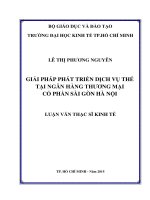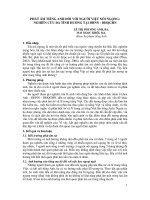Le thi phuong trang 11208048 reading day 9
Bạn đang xem bản rút gọn của tài liệu. Xem và tải ngay bản đầy đủ của tài liệu tại đây (44.56 KB, 3 trang )
Question 1: Read the 4 pages (from page 199 to 202) provided and explain the
price fluctuation of energy over time.
In the early 1970, the runup of energy prices was in fact of a political phenomenon.
It is not connected with scarcity factors. This problem led to very important
amounts of energy conservation. Users tent to save reduce their energy
consumption. By 1990, the real prices of some important items such as gasoline
had declined to pre-1970s levels but few people still gave much thought to energy
conservation.
Question 2: Read the file: Natural Resource Adequacy and and answer the
question: What is the viewpoint of pessimism and optimism toward this matter?
Pessimists studies arrive at the conclusion that natural resource scarcities and
several other factors would lead to preciptous declines in the output of modern
economies, beginning early in the 21 century. The pessimists can point to history to
support their view. The abundance of land and water adequately supplied every
material want, ministered liberally the every sensuous enjoyment. More than a half
of the Roman Empire’s extent is either deserted by civilized man and surrendered to
hopeless desolation, or at least greatly reduced in both productiveness and
population.
At the other end of the spectrum are the extreme optimists. They admit that natural
resource scarcities will surely occur in the future but human beings can overcom
this challenge by finding substitutes for resources that become scarce and bringing
population growth under control. The optimists can also call upon history to
support their position. When England began to experience severe wood shortages,
along came coal technology upon which to build the industrial revolution. When
coal started becoming scarce, petroleum technology was developed. When serious
food scarcities threatened the burgeoning population of Asia, the green revolution
was initiated to increase food production potential. When domestic energy prices
increased rapidly in the 1970s, American producers and consumers demonstrated a
surprising ability to adjust technologies and behaviors so as to conserve energy.
Question 3: What is your discussion about this matter?
The 1970s and early 1980s were the years of the energy crisis, a period of oil
shortages due to the OPEC trade embargo against the United States. Although a lot
of people at the time thought that this was due to the beginning of the real resource
shortage, the right reason for it was only a short-term political event that was not
long followed by price declines. In recent years, however, oil and gas prices have
skyrocketed again, and it's hard to know how much is due to real shortages, much
of it due to strong demand from fast-growing countries like China, and how much
is due to market manipulation by its members. The acceleration of oil prices in the
1980s and in recent years has been directing public attention to the question of the
fullness, first of oil supplies and then of other forms of energy, both fossils and
non-fossils. And How Congress Planned To Solve The 1970s Energy Crisis? The
first is to simply buy more oil from the Arabs. A second nonsolution is the all-out
dig-dam-drill approach. For a few years they'll have no choice but to
buy some Mideast oil. And there is some digging and drilling they should and can
do without environmental damage. But neither solution is tolerable in the long run.
For sooner or later (20-60 years depending on how pessimistic you are) mankind is
out of gas and oil. In a few centuries or less, you can scratch coal.
As I know, President Nixon responded to the energy crisis by instituting a strict
rationing program. In hindsight, this rationing program had more drastic effects at
home than did OPEC. The image of Americans waiting in long lines at the pump
for gasoline symbolized the end of a post-World War II era of economic growth
and prosperity and a new, uncertain future. President Carter directly addressed this
uncertainty in an address he delivered to the public in 1979, which came to be
known as the “crisis of confidence” speech. At the same time, Americans’
understanding of the threat of “foreign oil” dovetailed with existing racist ideas
about the Arabs and the Middle East, and U.S. popular culture produced a number
of racist depictions of foreign oil producers taking advantage of the American
public.









